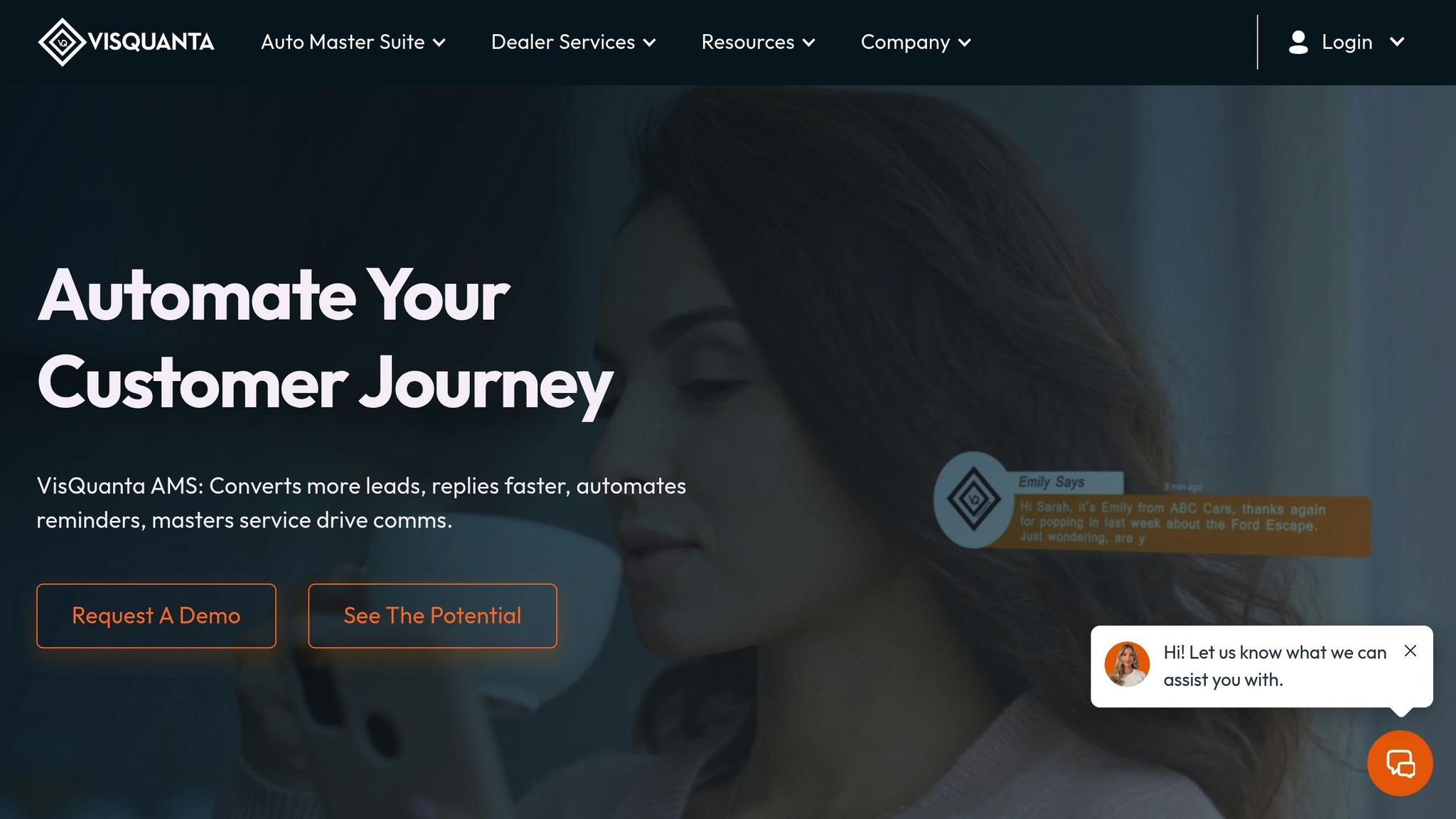First contact rates measure how effectively dealerships engage with potential customers during their initial outreach. Here's why this matters and how to improve:
- Speed is critical: 78% of customers buy from the first business to respond. Responding within 1 minute can boost conversions by 391%.
- Timing matters: 75% of consumers plan to buy within 3 weeks, with 40% ready to purchase in 1 week.
- Trust builds sales: 91% of buyers prioritize trust in their decision-making. Clear, honest communication during first contact is crucial.
- Phone leads perform best: Callers convert 30% faster than web leads and show higher retention rates.
Key Steps to Improve:
- Audit your process: Identify delays in response times, lead management, and follow-ups using CRM data.
- Train your team: Ensure sales staff are skilled, knowledgeable, and equipped with the right tools.
- Use AI and automation: Implement tools for instant lead capture, response, and routing to reduce delays.
- Track performance: Monitor metrics like response time, contact rates, and customer satisfaction to spot and fix issues.
Quick Tip:
Dealerships using AI tools like VisQuanta's AutoMaster Suite have reported up to 76% more after-hours lead conversions and a 20% increase in monthly sales. Fast, efficient responses make a difference.
First contact is your chance to set the tone for the entire customer experience. Focus on speed, trust, and proactive follow-ups to turn inquiries into sales.
Finding Problems in Your First Contact Process
Before you can fix issues, you need to figure out where things are going wrong. For instance, research shows that 27.5% of calls go unlogged, 11.7% of leads never make it into the system, and 65.4% of returning qualified leads face delayed follow-ups [5][7]. These aren't minor hiccups - they represent real revenue slipping through the cracks.
Here’s the silver lining: once you pinpoint these bottlenecks, you can tackle them step by step. As sales expert Lestraundra Alfred explains, "In sales, a bottleneck is an issue that causes a slow-down or blockage in your sales process" [3]. The challenge is knowing where to focus and what to measure. Start by thoroughly reviewing your lead management process to uncover inefficiencies.
Reviewing Your Lead Management Process
Your lead management process might seem flawless on paper, but real-world execution often tells a different story. To uncover weak points, map out every step - from the moment a lead enters the system to the first contact attempt.
Common bottlenecks to watch for include:
- Spending too much time on tasks that don’t generate revenue
- Overly complex sales processes
- Confusing pricing structures
- Misuse of technology
- Delays in approvals
- Lack of follow-up after the sale [3]
Each of these can add unnecessary time to your response process. Take a close look at your workflow. For example, how quickly does a lead move from your website form to a salesperson’s hands? What happens to leads submitted after hours? Are there approval steps slowing things down? Document every delay you find.
It’s also important to separate temporary disruptions from chronic issues [4]. A salesperson calling in sick or a temporary system glitch might cause short-term delays. But if leads sit in a queue every week because no one is assigned to monitor them, or if salespeople waste 20 minutes searching for customer details, that’s a long-term problem.
Key warning signs of bottlenecks include long wait times, backlogged tasks, and stressed-out team members [4]. If your team is constantly scrambling to catch up or if customers are complaining about slow responses, you’ve likely found your problem areas.
Using CRM Data to Find Problems
Your CRM is a goldmine of information when it comes to identifying inefficiencies. Use its analytics tools to track lead response times, follow-up rates, and conversion performance [6]. This data can confirm the operational gaps you uncovered during your process review.
Look for patterns based on time of day, day of the week, or lead source. For example, do leads from specific platforms consistently get slower responses? Is your team struggling to handle weekend inquiries?
Monitor performance metrics like lead sources, conversion rates, and response times [5]. Real-time dashboards are especially helpful - they let you spot issues as they arise rather than weeks later during monthly reviews. You might find that some team members excel with phone leads but struggle with online inquiries, or vice versa.
Surprising insights often emerge from this data. Perhaps your top-performing salesperson has excellent conversion rates but consistently slow response times. Or maybe website leads are converting better than showroom visits, yet they’re being deprioritized. Dashboards can also highlight which campaigns or platforms are delivering the best return on investment [8].
Don’t just rely on averages - dig deeper. A “10-minute average response time” might sound fine, but it could mask the fact that half your leads get responses in 2 minutes while the other half wait 18 minutes. Those delays are where you’re losing sales.
Checking Staff Training and Resources
Even the best systems can fail if your team isn’t equipped to use them effectively. Many operational issues stem from inadequate training or outdated tools. Successful lead management requires knowledgeable and well-trained sales staff [9].
Evaluate your team’s skills in areas like communication, product knowledge, and lead management [9]. Can they confidently handle objections? Do they know your inventory well enough to make quick recommendations? Are they equally comfortable with phone sales and face-to-face interactions?
Also, make sure employees have access to the right tools. It’s not just about having a phone and a computer [10]. Do they have mobile access to your CRM for when they’re away from their desk? Can they quickly pull up financing options? If they’re stuck using outdated systems, it could be slowing them down.
Determine whether performance issues stem from a lack of knowledge or motivation [10]. For instance, a salesperson who knows what to do but isn’t doing it might need different support than someone who’s eager but undertrained. You can also survey your team to find out which tools and software they rely on - and where they see gaps.
Harlene Doane, Chief Operations Officer at DealerStrong, offers a useful example: "If a service contract penetration is only 10% instead of the expected 30%, the deficiency cause could be that the employee is not making presentations of products to 100% of the customers, or the sales team is selling too much vehicle to allow enough room for back-end product" [10]. The same principle applies to first contact rates - low performance could point to training gaps, process flaws, or insufficient resources.
Track metrics like lead conversion rates, response times, and customer satisfaction [9], but don’t stop there. Talk to your team. They’re often the first to notice problems but may not speak up unless asked.
Using AI and Automation to Improve Speed-to-Lead
Addressing delays in first contact has become much easier thanks to advanced automation. Using AI tools, dealerships can drastically reduce the time it takes to respond to leads. Reaching out within five minutes makes dealerships 100 times more likely to connect with potential buyers [12]. And with 58.9% of qualified car dealership leads making a purchase within just three days [13], speed is everything. If you're not quick, someone else will be. The best-performing dealerships consistently respond within five minutes [13], leaving competitors struggling to keep up. This quick response sets the foundation for automated lead capture and instant routing.
Automating Lead Capture and Response
Human delays often slow down the lead response process, but AI-powered tools can change that. These tools capture leads from multiple platforms, qualify them instantly, and send immediate responses - no waiting for someone to check their email or return from lunch. With AI, dealerships have slashed lead-response times by over 80% [13]. For example, a Toyota dealership in California saw a 35% increase in appointment bookings after implementing an AI-driven system [12]. Similarly, a Texas Ford dealership reduced its response time from two hours to under four minutes, resulting in a 20% improvement in sales closures [12].
AI doesn't just speed things up; it makes lead management smarter. Predictive AI tools score and organize leads based on their likelihood to convert [11]. This means sales teams can focus on high-intent prospects rather than wasting time on unqualified leads. AI chatbots also work around the clock, answering questions, scheduling appointments, and collecting valuable information [11]. These bots keep potential buyers engaged while your team concentrates on closing deals. And when it comes to personalization, the numbers speak for themselves - customized messages can boost engagement by 80% and increase conversion rates by up to 33% [13].
Using VisQuanta's AutoMaster Suite

VisQuanta's AutoMaster Suite is a standout tool for tackling the speed-to-lead challenge. Its S2L (Speed to Lead) feature ensures instant responses across all channels, so no lead is left waiting [14]. As they put it, "If you're not first, you're last, and S2L ensures you're always first" [14]. The system captures leads from platforms like AutoTrader, Facebook, websites, and ad forms, offering comprehensive coverage [14]. It also filters out unqualified leads, sending only serious buyers to your sales team, saving time and effort [14].
The benefits are clear: dealerships using S2L have seen up to a 76% increase in after-hours lead conversions [14]. This is crucial since many customers browse and submit inquiries outside of regular business hours. Instead of letting these leads sit idle, the system ensures they're handled immediately when interest is at its peak. AutoMaster Suite also integrates seamlessly with existing DMS and CRM systems [14][15], so there's no need to overhaul your current setup. Features like automated follow-ups, appointment reminders, and post-sale check-ins create a complete lead management ecosystem. Dealerships have reported up to a 20% boost in monthly sales by re-engaging old leads [15], and up to 30% of cold leads have been reactivated, with 5-11% booking appointments again [15]. On top of that, VisQuanta clients enjoy a 93% faster lead response rate [15].
Benefits of Instant Lead Routing and Alerts
Real-time lead routing eliminates the delays caused by manual assignment. Leads are instantly directed to the most qualified salesperson based on their expertise and availability [1]. This ensures that every lead gets immediate attention from the right person.
Targeted alerts further streamline the process. Instead of blasting generic notifications to everyone, these alerts provide the right information to the right person at the right time [1]. Lead scoring also helps prioritize efforts. For instance, a lead who has visited your website multiple times, viewed specific vehicle pages, and submitted a form will rank higher than someone who simply clicked on an ad. This allows your team to focus on the hottest prospects while AI handles initial contact with lower-priority leads.
The results of these improvements are impressive. Dealerships using AI-powered solutions have improved follow-up consistency by over 90% [13]. Additionally, AI-driven lead qualification has boosted lead-to-sale conversion rates by 20-25% [13]. By automating routine tasks like data entry and initial follow-ups, AI frees up your team to do what they do best - build relationships and close deals [16].
Tracking and Monitoring First Contact Success
To improve, you need to measure. Keeping an eye on the right metrics can reveal where you're excelling and where there’s room to grow. When it comes to first contact success, consistent tracking and quick adjustments are essential to staying on top.
Key Metrics to Track
For first contact success, focus on three main areas: speed, effectiveness, and customer satisfaction. At the forefront is lead response time. Studies show that responding within five minutes makes you 100 times more likely to connect with a lead [20]. It’s crucial to monitor average response times across all channels, whether it’s phone, email, web forms, or social media.
Another important metric is First Contact Resolution (FCR), which tracks how often you successfully connect with a lead on the first try. This directly affects conversion rates by showing how well your initial outreach works. Alongside this, keep an eye on your contact rate - the percentage of leads you actually reach - and your conversion rate, which measures how many of those contacts lead to appointments or sales. Together, these numbers provide a clear picture of how effectively your team is engaging and driving results.
Customer satisfaction metrics add another layer of insight. Customer Satisfaction (CSAT) scores measure how leads feel about their first interaction with your dealership [18]. Customer Effort Score (CES) reveals how easy it is for customers to get the information they need [18], while Net Promoter Score (NPS) gauges whether they’d recommend your dealership after the initial contact [18].
Operational metrics are equally vital. Average Handling Time (AHT) shows how long these first interactions take, while the Agent Utilization Rate ensures your team’s capacity aligns with demand [19]. Finally, Cost per Lead (CPC) sheds light on how cost-efficient your first contact efforts are [17].
"77% of consumers say valuing their time is the most important thing a company can do to provide a great customer experience" [18].
This statistic highlights why speed is a critical factor in delivering an excellent first contact experience.
Setting Benchmarks and Goals
Industry averages can guide your initial goals, but it’s important to tailor them to your dealership’s specific needs. According to Foureyes data, contact rates for new vehicle internet leads average 60%, while phone leads perform better at 73%. For used vehicles, internet leads average 64%, and phone leads climb to 79% [21].
Interestingly, new vehicle phone leads dropped from 77% in July 2023 to 68% by April 2025 [22]. Despite this, phone leads still outperform internet leads, with 74% of phone leads turning into appointments compared to just 40% for internet leads [22]. Use these figures as a baseline, but aim for incremental improvements. For example, if your current internet lead contact rate is 45%, set a realistic goal of 50% for the next quarter instead of aiming too high too quickly. Also, consider breaking down goals by inventory type, as new and used vehicles often convert differently [22].
David Steinberg, CEO of Foureyes, stresses the importance of digging into the details:
"Dealers who are winning right now are the ones getting into the details of their sales process and making adjustments" [22].
Daily tracking is a must for catching issues early. While weekly or monthly reviews help identify trends, daily monitoring ensures you can address problems before they escalate. Setting goals for both individual team members and the group as a whole encourages accountability and keeps everyone aligned. Real-time dashboards can make this process even more effective by providing instant updates on your progress.
Using Dashboards for Real-Time Monitoring
Real-time dashboards are game-changers for turning raw data into actionable insights. They allow managers to quickly identify problems and seize opportunities as they arise.
Modern Dealer Management Systems (DMS) integrate seamlessly with Customer Relationship Management (CRM) tools, centralizing data and offering mobile-friendly dashboards for easy access [23]. These dashboards should clearly display key metrics like response times, contact rates, and conversion percentages.
Call monitoring software can also elevate your team’s performance. For instance, in March 2025, Convin reported a 37% improvement in call quality scores over four months, a 95% customer satisfaction rate, and a 35% reduction in high escalation cases [24].
Dashboards can also include alerts for critical situations. For example, set up notifications for when response times exceed five minutes, contact rates dip below a certain threshold, or when specific team members may need extra support. By designing dashboards around essential metrics, you can maintain a clear view of your dealership’s performance and quickly spot trends [23].
As Joe Brellahan from Greg Lilly Auto Sales Inc shared:
"The entire system is very versatile, and everything is one place, my DMS, CRM, Website, and online marketing all in one! The mobile app is killer! I can scan my VINS and scan my customer's drivers licenses to save me so much time!" [25].
When choosing dashboard tools, prioritize those that integrate seamlessly with your existing systems. The goal is to simplify monitoring, not add unnecessary complexity to your team’s workflow.
sbb-itb-0329cfa
Practical Steps to Boost First Contact Rates
Once you have effective metrics and monitoring in place, it’s time to implement strategies that can genuinely improve your first contact rates. From refining communication tactics to leveraging the right tools and building accountability, these steps will help your dealership connect with leads more effectively.
Improving Communication and Lead Handling
Strong communication is the backbone of better first contact rates. Quick and personalized responses make a huge difference - responding within 5 minutes can significantly increase conversions, and 78% of buyers go with the company that responds first [8].
Personalization is key. Address leads by their first name and reference the specific vehicle they’re interested in [26]. These small details show attention to their needs and make them feel valued. In fact, studies reveal that 71% of consumers expect personalized interactions, and 76% get frustrated when they don’t receive them [27].
Today’s customers use multiple channels, so your communication strategy should too. While phone calls still matter, 90% of customers prefer text messages over calls when interacting with brands [27]. Even more compelling, 95% of texts are read and responded to within 3 minutes [27]. When crafting messages, focus on being helpful and informative. Share the details they need, offer choices to give them a sense of control, and always include a clear call to action [26].
Persistence in follow-ups is equally important but should be tactful. Set up a structured follow-up schedule using automated responses and targeted calls [8]. This ensures consistent outreach without overwhelming prospects, keeping your dealership top-of-mind.
Adding Smart Tools to Reduce Friction
Great communication is essential, but integrating the right tools can make the lead response process even smoother. Automation tools are a game-changer, helping dealerships improve response times and contact rates. Dealerships using automation report 20–40% faster response times and a 10–15% increase in closing rates [29].
Features like live chat and click-to-call let you engage visitors immediately when they’re actively browsing your site [2]. These tools help capture interest before it fades.
For a more comprehensive solution, platforms like VisQuanta’s AutoMaster Suite integrate with existing CRMs to automate database reactivation and improve speed-to-lead performance. This system not only reduces lost leads but also supports sales training initiatives to boost conversions and retention.
Automated follow-up systems can segment leads based on their intent. High-intent leads get immediate attention, while medium- and low-intent prospects are nurtured over time [28]. This ensures timely and relevant follow-ups for every lead.
Smart scheduling tools also simplify appointment setting. Allowing leads to book directly online eliminates back-and-forth coordination. Automated SMS confirmations further reduce no-shows and keep appointments fresh in customers’ minds.
Building a Culture of Accountability
Even with strong communication and advanced tools, success depends on consistent execution. Creating a culture of accountability ensures these strategies are part of your dealership’s daily operations, not just a temporary push.
Start by setting clear performance standards for response times, lead handling, and follow-ups [31]. When everyone knows what’s expected, it’s easier to track progress and provide targeted coaching.
Regular performance tracking and one-on-one meetings are essential. Weekly check-ins give managers a chance to discuss progress, tackle challenges, and set goals with team members [31]. Use specific data from your CRM and tracking tools to guide these conversations.
"A leader's enthusiasm is contagious. If you're not the first to model empathy and urgency, don't expect your team to care."
– Laura Troyano, Automotive Consultant [31]
Call tracking and monitoring also play a critical role. Knowing their calls are tracked encourages team members to follow procedures and maintain professionalism. Recorded calls can double as training tools to sharpen communication skills.
Tying compensation to performance is another effective motivator. Reward team members for meeting contact rate goals, hitting response time targets, and achieving conversion milestones [31]. This aligns individual success with dealership objectives and drives consistent effort.
Daily check-ins help maintain alignment and accountability. As Stacey Ellison, the "CRM Queen", advises, holding brief morning, midday, and end-of-day check-ins keeps everyone connected and focused, even remote workers .
"Do today what will make you money today."
– Stacey Ellison, CRM Queen
Empowering employees strengthens accountability as well. Encourage team members to create quarterly business plans for their responsibilities and share ideas for improvement [31]. When employees take ownership of the process, they’re more likely to stick with it.
Finally, balance accountability with support. Celebrate wins publicly to boost morale and confidence, and address challenges privately with actionable feedback [32]. This approach maintains high standards while helping each team member grow and succeed.
Conclusion: Getting Consistent First Contact Success
Key Points Review
Achieving consistent success with first contact requires a blend of effective processes, smart technology, and a strong team culture. Top-performing dealerships know that speed-to-lead is everything - responding within 5 minutes can boost the chances of securing a sale by an incredible 20x [14].
This guide has highlighted the importance of identifying gaps in your current approach. By leveraging CRM analytics, assessing staff training needs, and reviewing available resources, you can pinpoint where your dealership stands and where improvements are needed.
AI-driven automation is reshaping how dealerships handle first contact. Tools like VisQuanta's AutoMaster Suite illustrate how instant responses across all channels can prevent missed opportunities. The suite’s S2L (Speed-to-Lead) feature ensures prompt follow-ups, keeping potential sales from slipping through the cracks.
Tracking performance regularly is key to maintaining progress. Setting benchmarks, monitoring metrics like response times and conversion rates, and using real-time dashboards help your team stay focused on what drives results. Data shows that dealerships using comprehensive automation solutions can achieve up to a 20% increase in monthly sales by effectively re-engaging their old database [33].
Accountability is the glue that turns short-term gains into lasting success. When communication strategies, advanced tools, and a strong team culture align, dealerships create an environment where consistent first contact success becomes standard practice.
Next Steps for Dealership Leaders
Quick, automated responses are no longer optional - they’re essential for capturing every sales opportunity. Start by evaluating your current first contact process. How fast are your response times? Are leads being handled effectively across all channels? Is your team equipped to respond promptly during and outside of business hours?
Consider adopting a solution that tackles multiple aspects of lead management at once. For example, in Q3 2024, five franchise dealerships across the US implemented VisQuanta's AutoMaster Suite. Within just 90 days, they saw a 15% increase in appointments booked from online leads. Before using the suite, their average response time was 4 hours. After implementation, it dropped to under 5 minutes, resulting in significant revenue growth tied to faster lead engagement.
Look for tools that integrate seamlessly with your existing CRM and DMS systems. Features like automated lead capture, instant qualification, and real-time tracking are critical. VisQuanta’s AutoMaster Suite, for instance, maintains a 98% dealer satisfaction rate while delivering these capabilities [33][34].
However, technology alone won’t guarantee success. Continuous training for your team and clear performance standards are equally important. Regularly reviewing your lead management processes ensures you stay ahead of evolving customer expectations and technological changes. Metrics like response times, contact rates, and conversion percentages remain the benchmarks for sustained growth.
Dealerships that commit to improving their lead management processes - through smart tools, solid strategies, and team dedication - can achieve measurable gains in both customer engagement and revenue. With the right steps, your dealership can join the ranks of those consistently excelling in first contact success.
FAQs
How can dealerships use AI and automation to boost first contact rates?
Dealerships can tap into the power of AI and automation to boost their first contact rates by cutting down response times and engaging with leads more quickly. Tools like AI-driven chat systems or automated response platforms allow dealerships to reply to inquiries within minutes - a crucial window to grab a potential customer's attention.
Using strategies like speed-to-lead, dealerships can focus on quick follow-ups, which often leads to higher lead-to-sale conversion rates. AI tools also play a key role in nurturing leads by maintaining consistent and personalized communication. This approach not only strengthens customer relationships but also enhances connection rates, improves customer satisfaction, and boosts overall dealership performance.
What are the biggest challenges in managing dealership leads, and how can they be resolved?
Dealerships often struggle with hurdles like delayed response times, ineffective lead qualification, and inadequate tracking of prospects. These challenges can lead to missed sales opportunities and a drop in conversion rates.
To tackle these issues, dealerships can implement solutions such as automating follow-ups, fine-tuning lead qualification methods, and fostering better collaboration between sales and marketing teams. AI-driven tools like VisQuanta’s AutoMaster Suite play a key role by improving speed-to-lead, reactivating dormant databases automatically, and simplifying workflows. These tools enable dealerships to engage with leads more quickly, enhance sales productivity, and drive higher revenue.
Why is responding quickly to leads so important for car dealerships, and how fast should they aim to respond?
Responding to leads quickly is a game-changer for car dealerships. Studies reveal that reaching out to a lead within the first minute can increase conversion rates by an impressive 400%. This kind of speed not only grabs the customer’s attention but also strengthens trust and enhances the overall buying experience - a key factor in standing out in a crowded market.
To keep up with the competition, dealerships should strive to respond to new inquiries within 1 to 5 minutes. Acting swiftly keeps potential buyers engaged while their interest is still high and minimizes the chance of them turning to a competitor. In short, speed-to-lead is crucial for boosting connection rates and making the most of every sales opportunity.
.avif)




.jpeg)

.avif)




.svg)

